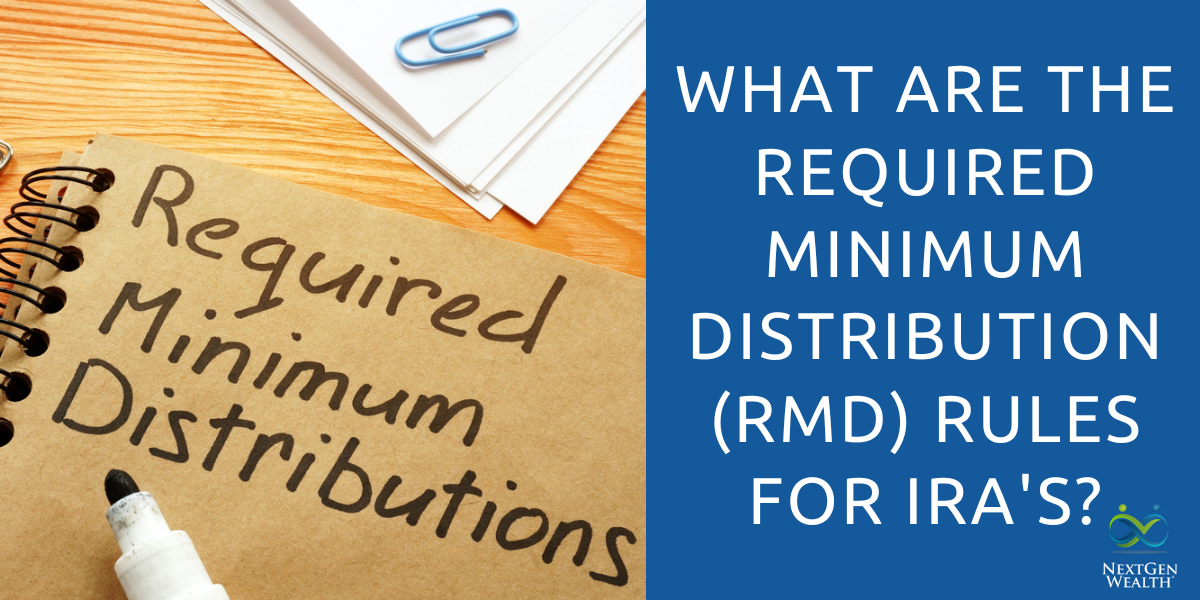What are the Required Minimum Distribution (RMD) rules for IRA's?

This post was last updated on July 24, 2024, to reflect all updated information and best serve your needs.
The IRS established required minimum distribution (RMD) rules on IRAs and similar tax-deferred savings plans to eventually collect on the taxes previously deferred. RMD rules require you to begin making withdrawals from certain retirement accounts when you reach age 73.
Without these measures, you could potentially let retirement accounts continue to grow. If you have other sources of income, you could let these accounts continue earning and then pass them on to your heirs. Keeping track of required minimum distributions for IRAs is important when you're planning for retirement.
Need help navigating your retirement income options? Get your free retirement income plan today!
What Accounts Have Required Minimum Distributions?
Not all retirement plans are subject to RMDs and don't necessarily carry the same rules. The following accounts may have required minimum distributions:
- Employer-sponsored retirement plans, such as 401(k), 403(b), 457(b), and any profit-sharing plans.
- Traditional IRAs.
- IRA-based plans, such as SIMPLE IRAs, SEPs, and SARSEPs.
Roth IRAs are unique in that they do not require disbursements until the account holder dies. The beneficiaries, however, may face penalties if they do not adhere to RMDs when they take possession of the funds.
When Do RMDs Start?
The Setting Every Community Up for Retirement Enhancement (SECURE) Act was instituted in 2019, changing many of the rules for RMDs. Prior to the change, any person who turned 70 ½ years old before 2020 had to take their first RMD by April 1, 2020. The SECURE Act changed the age requirement to age 72, meaning that if you turn 72 in 2021, the first RMD would need to be taken out by April 1, 2022.
With the passing of SECURE 2.0, RMDs don't start until age 73. In 2033, this will increase to age 75.
After the first year, RMDs that follow are due by December 31st each year. Account owners must take care to withdraw in a timely fashion, as a delayed payment will force them to make two payments in their first year of RMDs — the distribution due on April 1 and one by December 31. This carries financial risk, as both distributions are counted as income, which could lift you into a higher tax bracket for the year.
What is the RMD Amount for My IRA?
The required minimum distribution for IRAs is calculated through two elements — the previous year’s IRA balance and a life expectancy factor established by the IRS. The account balance, or fair market value, is the year-end amount in the IRA. If you are paying your RMD for 2023, it would be based on the IRA’s account balance on December 31, 2022.
The life expectancy component is age-based. The IRS created life expectancy tables for different circumstances to use in calculating your RMD:
- The Joint and Last Survivor Table: This table is used when your spouse is the IRA’s only beneficiary and he/she is over 10 years younger than you.
- Uniform Lifetime Table: This table is used when your spouse is not the account’s only beneficiary or they are within 10 years of age to you. This is the most common calculation used.
A separate table works for inherited IRAs. On the Uniform Lifetime table, each age from 72 on has an associated life expectancy factor, or “distribution period”, ranging from 27.4 to 2.0. The factor decreases as you age.
The RMD is calculated by dividing the IRA’s account balance by the age-based factor. For example, a 75-year-old, will have a factor of 24.6, according to the 2023 table. If they have an IRA with $200,000 in it on December 31, 2022, the calculation would be 200,000/24.6, equaling an $8,130 RMD for 2023.
The RMD is just the minimum required withdrawal amount, so you could withdraw up to 100% of the IRA’s value in a single year. However, IRA withdrawals are taxable income could push you into higher tax brackets and leave you with a sizable tax bill.
The account custodian or administrator are required to inform you and the IRS of accounts subject to RMDs. However, the account holder has the ultimate legal responsibility for taking the distributions and paying the taxes.
Traditional IRA taxes are included as normal taxable income. Roth IRA withdrawals are excluded form taxable income (tax-exempt) because taxes were already paid on contributions.
Need help navigating your retirement income options? Get your free retirement income plan today!
What If I Have Other Retirement Accounts?
If you have several IRAs, you do not have to withdraw separate RMDs from each one. However, you do need to calculate the RMD for each individual account. You can then withdraw the total from a single account or spread it out over several.
To protect against tax abuse, the IRS does require that RMDs from different account types, like 401(k) plans, be calculated and withdrawn separately. Only IRAs can be lumped together for a single distribution. Furthermore, RMD amounts cannot be transferred into a separate tax-deferred account.
What are the Rules If I Inherit an IRA?
The SECURE Act changed the age requirement for distributions and rules for inherited IRAs.
The SECURE Act established these rules to get rid of stretch IRAs, a strategy that beneficiaries could use to continuously roll IRA amounts into new tax-deferred accounts. However, spouses do have other options available, such as a transfer to their own IRA or treating the inherited IRA as their own.
If a non-spouse beneficiary is considered an "Eligible Designated Beneficiary," they may be able to stretch RMDs out over their own life expectancy or possibly within 10 years.
If the beneficiary is not a designated beneficiary, the inherited IRA must be completely distributed within 5 years.
Although Roth IRAs have no RMDs for the account holder during their lifetime, if you inherit a Roth account, you will still be subject to these distribution rules.
Additional Changes from the IRS
In July 2024, the IRS issued final regulations regarding RMDs on inherited retirement accounts among other things. Specifically, they clarified that "non-eligible" beneficiaries must take annual distributions. Before, it was assumed you just had to deplete the account within ten years following the death of the original account holder.
There are many other nuances regarding which beneficiaries take what RMDs. If there are multiple beneficiaries, you'll need to ensure you're in compliance so you're not hit with a penalty.
Also, if 100% of the balance is in a Roth account, no annual distributions are necessary. Therefore, if you want the most flexibility, you should consider rolling all Roth account balances into a Roth IRA. This would allow you to keep the money invested in a Roth account until the end of the 10-year period.
What Happens If I Don’t Take an RMD?
If an account owner does not take a required minimum distribution by the deadline, they face a 25% excise tax on the funds not withdrawn. They will be required to fill out IRS Form 5329 for that year’s federal tax return to honor their tax obligation. This form, along with an explanation letter, can be used to attempt to waive the penalty if the failure to take out the RMD was due to a reasonable error.
Otherwise, the penalty may be reduced to 10% if corrected in a reasonable timeframe within the "correction window." The "correction window" starts the day the RMD was due until one of the following:
- The date the notice of deficiency is mailed to you
- The date on which the tax is assessed
- The end of the second taxable year after the tax is imposed
Need help navigating your retirement income options? Get your free retirement income plan today!


